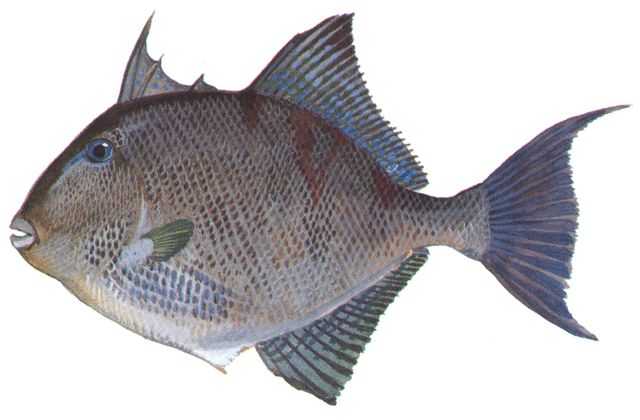Grey Triggerfish

Species Details
Balistes Capriscus
Balistidae
Tetraodontiformes
Inshore, offshore
11 - 13 lbs.
19" - 24"
Grey Triggerfish (Balistes capriscus) Fish Description
Grey Triggerfish, also referred to as the Leatherjacket, Leatherneck, or Taly, is a ray-finned fish.
They primarily have a pale grey, greenish-grey, or yellowish-brown hue. Its body has three indistinct broad dark stripes, and a pale streak on its chin. The upper part of their eye is blue. There are occasionally some small blue spots and lines on the upper parts of its body and the dorsal fins and sometimes white spots and lines on the lower areas. The body color of the Grey Triggerfish fades a little over time as it gets older.
To distinguish them from their species, the Grey Triggerfish has a small, beak-like mouth and by the tip of the snout, it has fleshy lips. Their eyes are far back, near the top of its head. For its body, it's rather laterally compressed and with tough, leather-like skin. The front dorsal fins have three spines, the first spine being stronger and longer in comparison to the other two. The second dorsal fin has 26-29 soft rays, and is the same shape and size as the anal fin below it, but has no spines and 23-26 soft rays. The pectoral fins of the Grey Triggerfish are small and rounded. And the caudal fins outer rays are large and long. They have large scales on their head and front of the body, and smaller, smoother scales on their hind.
Diet and Size
Grey Triggerfish are carnivores. They consume prey such as crabs, shrimp, sea urchins, worms, and other invertebrates or smaller fish. They often pick at clams and other animals attached to corals, as they are known to wreak havoc on less than fortunate reef dwellers.
The Grey Triggerfish is a medium-sized fish that can grow to 24 in, but their average length is no longer than 17 in. And they can weigh up to 13 pounds.
Interesting Facts
- When the Grey Triggerfish feel threatened, they can slip into small crevices, using their distinct shape, and erect their dorsal fins to lock them into place, firmly wedging themselves in their hiding spot.
- Grey Triggerfish have such sharp teeth, that they can use them to cut into preys with hard shells, like sea urchins and starfish.
- Smaller fish often follow Grey Triggerfish, because these fish are notably to wreak havoc on the lesser fortuned reef dwellers that the small fish can feast on the leftovers.
Fishing Techniques
As an angler, when fishing for a Grey Triggerfish, you’d best try bodies of water with hard bottoms, ledges, and reefs. They are often found in nearshore and offshore locations, in seaward reefs, bays and lagoons just about 180 ft. from the surface.
This type of fish would go for almost any bait thrown towards its direction, but you can try squid because it sticks better onto the hooks in comparison to other baits. When using squid, a chunk that is about an inch wide would be good so it wouldn’t slip off when fishing. Since Grey triggerfish tend to nip at the bait before taking it in, unlike snapper fish, you can try appealing to their greed towards food by dropping your bait near other fish, like some snapper or grouper. So when the Grey Triggerfish see the others heading towards the bait, they’ll charge on out to steal it!
When you drop your baited hook to the bottom, (and remember, since Grey Triggerfish are located near the bottom, to use a 6 to 8 ounces heavy sinker,) reel it immediately to maintain the line tension, so you can feel even the softest of bites. Then when you feel a bite, start reel it in as fast as you can while keeping the rod stable.
Habitat and Distribution
Grey Triggerfish can be found in Florida, but also inhabit parts of the South and Western Atlantic Ocean.
The Grey Triggerfish principally lives in shallow waters. Its native range goes from Nova Scotia and up to the Caribbean Sea, the Gulf of Mexico, Bermuda, and southwards to Argentina. They are often found in nearshore and offshore locations, in seaward reefs, rocky areas, bays, and lagoons just about 180 ft. from the surface.
As a result of the movement of water in the Gulf Stream, they may have crossed the Atlantic, around the British Isles, in the Mediterranean Sea, and off the coast of Angola.







